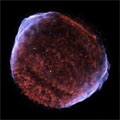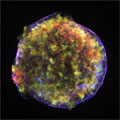An overview of the Chandra mission and goals, Chandra's namesake, top 10 facts.
Classroom activities, printable materials, interactive games & more.
Overview of X-ray Astronomy and X-ray sources: black holes to galaxy clusters.
All Chandra images released to the public listed by date & by category
Current Chandra press releases, status reports, interviews & biographies.
A collection of multimedia, illustrations & animations, a glossary, FAQ & more.
A collection of illustrations, animations and video.
Chandra discoveries in an audio/video format.
Blasts From The Past Impact Science
by WKT
December 13, 2006 ::
In centuries past, there was a belief that the stars governed our fate through "cosmic sympathy." Occurrences in the Macrocosm, or the heavens, were thought to presage fateful events in the Microcosm such as success or failure in battle, or the death of a powerful ruler.
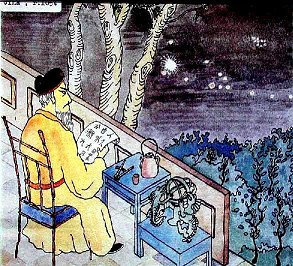
Source: Astro Nukl Fyzika |
For this reason, court astrologers took their work seriously, and well they should have, because their lives literally depended on it - they could be executed for failure to predict an eclipse. Today's astronomers are beneficiaries of the meticulous record-keeping of ancient Chinese, Japanese, Korean, Arabic and European observers.
An excerpt from the chronicles of the Sung Dynasty that contains an account of the observation of the supernova that produced the Crab Nebula gives a flavor of the times, and the conditions under which the court astrologers worked:
"Prostrating myself, I have observed the appearance of a guest star; on the star there was a slightly iridescent yellow color. Respectfully, according to the dispositions of the Emperor, I have prognosticated, and the result said: The guest star does not infringe on Aldebaran; this shows that the Plentiful One is Lord and that the country has a Great Worth."
Interdisciplinary research by historians and astronomers provide a valuable record that dates some of the most violent events that have occurred in our Galaxy over the past two millennia. Current estimates suggest that about three dozen supernovas should have occurred in the Galaxy over that time. The relative scarcity of reported supernovas may be due to several factors. For example, many events could have been in the Southern sky, others could have occurred on the far side of the Galaxy and some might have been embedded in obscuring clouds of dust and gas.
The records contain many reports of "new stars," and "guest stars," and "stellae novae," but only a few of them were supernovas. The supernovas are distinguished by two criteria: (1) the duration of time over which they could be observed (at least three months, and as long as 3 years in the case of the supernova of 1006 AD), and (2) by the discovery in modern times of expanding supernova remnants of hot gas and energetic particles at the locations of the reported supernovas.
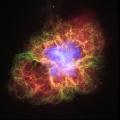 |
Composite Image of Cra Nebula
Credit: X-ray: NASA/CXC/ASU/J.Hester et al.; Optical: NASA/ESA/ASU/J.Hester & A.Loll; Infrared: NASA/JPL-Caltech/Univ. Minn./R.Gehrz |
Eight well-recorded events that meet these criteria are listed in the accompanying table, along with the puzzling case of Cassiopeia A (Cas A). The observed expansion of the Cas A supernova remnant indicates that it was produced in a supernova about 335 years ago, so it should have been observed around 1671 AD. In 1680 the British astronomer John Flamsteed observed a star that was near the position of Cas A. This star was never seen again, so it could well have been the explosion that produced Cas A. However, this identification is controversial and may have referred to another star at a nearby position.
The brightest supernova observed was the supernova of 1006 AD, which was brighter than Venus and visible for several years. However, the remnant of SN 1006 has not attracted nearly as much attention as the supernova of 1054 AD, which produced the Crab Nebula.
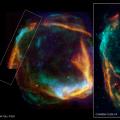 |
Composite Image of RCW 86
Credit: Chandra: NASA/CXC/Univ. of Utrecht/J.Vink et al. XMM-Newton: ESA/Univ. of Utrecht/J.Vink et al. |
This is because SN 1006 was likely produced by a thermonuclear explosion that completely disintegrated a white dwarf star (a Type Ia explosion), leaving nothing behind except the expanding stellar debris. In contrast, the Crab Nebula was the product of the collapse of the core of a massive star. The collapse triggered a Type II supernova that ejected most of the star, but left behind a rapidly spinning neutron star. This cosmic dynamo produces a tornado of magnetic fields and high-energy particles that continue to light up the expanding debris.
 |
| Source: Wikipedia |
The detection by Chandra of rapidly spinning neutron stars in supernova remnants is proving to be one of the best ways to distinguish between the types of supernova explosions, and thereby to understand the nature of the star that exploded.
All the historical supernovas occurred thousands of light years away, so their physical effects on Earth were negligible. However, one supernova played an important role in the development of modern physics and astronomy.
The supernova of 1572 occurred before the invention of the telescope, but Tycho Brahe used an ingenious array of instruments to make accurate measurements of the position of the "new star" relative to other stars in the constellation Cassiopeia. For 18 months, though the brightness of the star declined steadily until it became invisible, its position remained fixed. This proved that the object belonged to the "Eighth Sphere" of the fixed stars. The explosion of the star had shattered forever the widely accepted doctrine in the incorruptibility of the stars, and set the stage for the work of Kepler, Galileo, Newton and others.
| Date |
Constellation |
Duration of Visibility |
Remnant |
Peak Brightness Comparable to: |
Historical Records |
| AD 185 | Centaurus | ~ 1 yr | RCW 86
G315.4-2.3 | Mars | Chinese |
| AD 386 | Sagittarius | 3 months | G11.2-0.3 | ? | Chinese |
| AD 393 | Scorpius | 8 months | ? | Jupiter | Chinese |
| AD 1006 | Lupus | 3 years | SNR 1006 | About 10 times brighter than Venus. The brightest SN. | Chinese, Japanese, Arabic, European |
| AD 1054 | Taurus | 21 months | Crab Nebula | Venus | Chinese, Japanese, Arabic, Native American? |
| AD 1181 | Cassiopeia | 6 months | 3C58 | Sirius | Chinese, Japanese |
| AD 1572 | Cassiopeia | 18 months | Tycho SNR | Venus | Chinese, Korean, European |
| AD 1604 | Ophiuchus | 12 months | Kepler SNR | Brighter than Jupiter | Chinese, Korean, European |
| AD 1670 | Cassiopeia | ? | Cas A SNR | Undetectable | ? |
REFERENCES:
J. Duyvendak, 1942 Proceedings Astronomical Society Pacific 54, 91
D. A. Green and F.R. Stephenson, 2003, "The Historical Supernovae"
astro-ph/0301603
F. R. Stephenson and D.A. Green, 2002 Historical Supernovae and Their Remnants,
(Oxford Univ. Press, Oxford)


